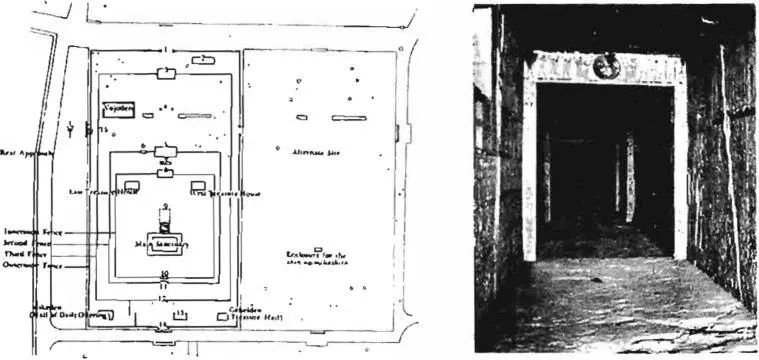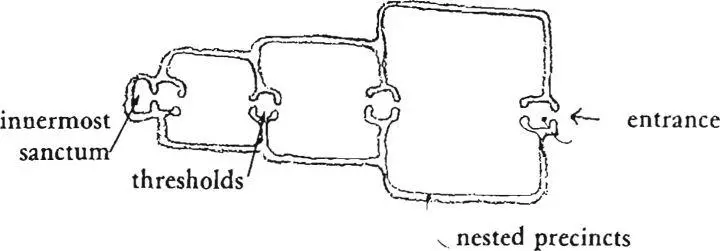Christopher alexander - A pattern language
Здесь есть возможность читать онлайн «Christopher alexander - A pattern language» весь текст электронной книги совершенно бесплатно (целиком полную версию без сокращений). В некоторых случаях можно слушать аудио, скачать через торрент в формате fb2 и присутствует краткое содержание. Жанр: Прочая научная литература, на английском языке. Описание произведения, (предисловие) а так же отзывы посетителей доступны на портале библиотеки ЛибКат.
- Название:A pattern language
- Автор:
- Жанр:
- Год:неизвестен
- ISBN:нет данных
- Рейтинг книги:3 / 5. Голосов: 1
-
Избранное:Добавить в избранное
- Отзывы:
-
Ваша оценка:
- 60
- 1
- 2
- 3
- 4
- 5
A pattern language: краткое содержание, описание и аннотация
Предлагаем к чтению аннотацию, описание, краткое содержание или предисловие (зависит от того, что написал сам автор книги «A pattern language»). Если вы не нашли необходимую информацию о книге — напишите в комментариях, мы постараемся отыскать её.
A pattern language — читать онлайн бесплатно полную книгу (весь текст) целиком
Ниже представлен текст книги, разбитый по страницам. Система сохранения места последней прочитанной страницы, позволяет с удобством читать онлайн бесплатно книгу «A pattern language», без необходимости каждый раз заново искать на чём Вы остановились. Поставьте закладку, и сможете в любой момент перейти на страницу, на которой закончили чтение.
Интервал:
Закладка:
Include rooms where after the birth the mother and her baby can stay together with the other members of the family—sleep together, eat together, cook together— common areas at the HEART(129), couple’s REALM (I36), FARMHOUSE KITCHEN(139) ; provide a partly private garden to walk in— half-hidden garden(ill), garden wall(17 3) ; for the shape of the building, gardens, parking, and surroundings, begin with building complex(95). . . .
| 66 HOLY GROUND* | |
|---|---|
 |
~rr |
331
. . . we have defined the need for a full life cycle, with rites of passage between stages of the cycle—life cycle (26) ; and we have recommended that certain pieces of land be set aside because of their importance and meaning—sacred sites (24). This pattern gives the detailed organization of the space around these places. The organization is so powerful, that to some extent it can itself create the sacredness of sites, perhaps even encourage the slow emergence of coherent rites of passage.
*2» •{-
What is a church or temple? It is a place of worship, spirit, contemplation, of course. But above all, from a human point of view, it is a gateway. A person comes into the world through the church. He leaves it through the church. And, at each of the important thresholds of his life, he once again steps through the church.
The rites that accompany birth, puberty, marriage, and death are fundamental to human growth. Unless these rites are given the emotional weight they need, it is impossible for a man or woman to pass thoroughly from one stage of life to another.
In all traditional societies, where these rites are treated with enormous power and respect, the rites, in one form or another, are supported by parts of the physical environment which have the character of gates. Of course, a gate, or gateway, by itself cannot create a rite. But it is also true that the rites cannot evolve in an environment which specifically ignores them or makes them trivial. A hospital is no place for a baptism; a funeral home makes it impossible to feel the meaning of a funeral.
In functional terms, it is essential that each person have the opportunity to enter into some kind of social communion with his fellows at the times when he himself or his friends pass through these critical points in their lives. And this social communion at this moment needs to be rooted in some place which is recognized as a kind of spiritual gateway for these events.
What physical shape or organization must this “gateway” have
33 266 HOLY GROUND
in order to support the rites of passage, and in order to create the sanctity and holiness and feeling of connection to the earth which makes the rites significant.
Of course, it will vary in detail, from culture to culture. Whatever it is exactly that is held to be sacred—whether it is nature, god, a special place, a spirit, holy relics, the earth itself, or an idea—it takes different forms, in different cultures, and requires different physical environments to support it.
However, we do believe that one fundamental characteristic is invariant from culture to culture. In all cultures it seems that whatever it is that is holy will only be felt as holy, if it is hard to reach, if it requires layers of access, waiting, levels of approach, a gradual unpeeling, gradual revelation, passage through a series of gates. There are many examples: the Inner City of Peking; the fact that anyone who has audience with the Pope must wait in each of seven waiting rooms; the Aztec sacrifices took place on stepped pyramids, each step closer to the sacrifice; the Ise shrine, the most famous shrine in Japan, is a nest of precincts, each one inside the other.
 |
| Layers of access. |
Even in an ordinary Christian church, you pass first through the churchyard, then through the nave; then, on special occasions, beyond the altar rail into the chancel and only the priest himself is able to go into the tabernacle. The holy bread is sheltered by five layers of ever more difficult approach.
This layering, or nesting of precincts, seems to correspond to
333
a fundamental aspect of human psychology. We believe that every community, regardless of its particular faith, regardless of whether it even has a faith in any organized sense, needs some place where this feeling of slow, progressive access through gates to a holy center may be experienced. When such a place exists in a community, even if it is not associated with any particular religion, we believe that the feeling of holiness, in some form or other, will gradually come to life there among the people who share in the experience.
Therefore:
In each community and neighborhood, identify some sacred site as consecrated ground, and form a series of nested precincts, each marked by a gateway, each one progressively more private, and more sacred than the last, the innermost a final sanctum that can only be reached by passing through all of the outer ones.

At each threshold between precincts build a gate—main gateways (53) ; at each gate, a place to pause with a new view toward the next most inner place—zen view (134); and at the innermost sanctum, something very quiet and able to inspire—perhaps a view, or no more than a simple tree, or pool—pools and
STREAMS (64) , TREE PLACES (1 7 I ) . . . .
in each house cluster and work community }provide the smaller bits of common land yto provide for local versions of the same needs:
| 67. | COMMON LAND |
| 06V-O | CONNECTED PLAY |
| 69. | PUBLIC OUTDOOR ROOM |
| 70. | GRAVE SITES |
| 71- | STILL WATER |
| 72. | LOCAL SPORTS |
| 73- | ADVENTURE PLAYGROUND |
| 74- | ANIMALS |
335
CHOOSING A LANGUAGE FOR YOUR SUBJECT
For this reason, of course, the task of choosing a language for your project is fundamental. The pattern language we have given here contains 253 patterns. You can therefore use it to generate an almost unimaginably large number of possible different smaller languages, for all the different projects you may choose to do, simply by picking patterns from it.
We shall now describe a rough procedure by which you can choose a language for your own project, first by taking patterns from this language we have printed here, and then by adding patterns of your own.
1. First of all, make a copy of the master sequence (pages xix-xxxiv) on which you can tick off the patterns which will form the language for your project. If you don’t have access to a copying machine, you can tick off patterns in the list printed in the book, use paper clips to mark pages, write your own list, use paper markers— whatever you like. But just for now, to explain it clearly, we shall assume that you have a copy of the list in front of you.
2. Scan down the list, and find the pattern which best describes the overall scope of the project you have in mind. This is the starting pattern for your project. Tick it. (If there are two or three possible candidates, don’t worry: just pick the one which seems best: the others will fall in place as you move forward.)
Читать дальшеИнтервал:
Закладка:
Похожие книги на «A pattern language»
Представляем Вашему вниманию похожие книги на «A pattern language» списком для выбора. Мы отобрали схожую по названию и смыслу литературу в надежде предоставить читателям больше вариантов отыскать новые, интересные, ещё непрочитанные произведения.
Обсуждение, отзывы о книге «A pattern language» и просто собственные мнения читателей. Оставьте ваши комментарии, напишите, что Вы думаете о произведении, его смысле или главных героях. Укажите что конкретно понравилось, а что нет, и почему Вы так считаете.












